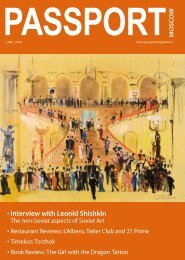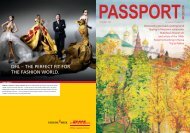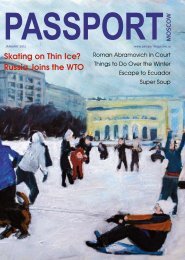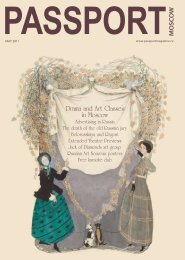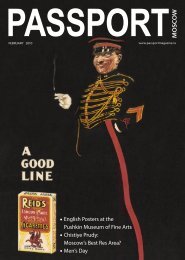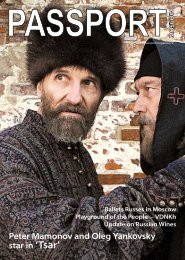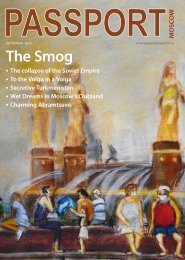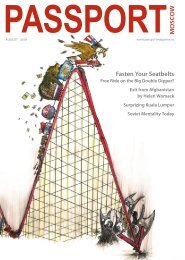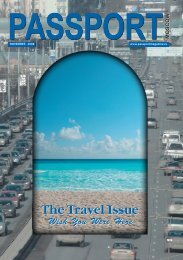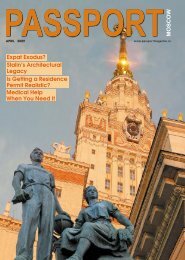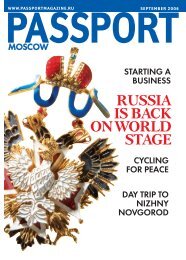Part one of Passport's guide to Moscow's favorite - Passport magazine
Part one of Passport's guide to Moscow's favorite - Passport magazine
Part one of Passport's guide to Moscow's favorite - Passport magazine
Create successful ePaper yourself
Turn your PDF publications into a flip-book with our unique Google optimized e-Paper software.
stagnation, but only knots <strong>of</strong> nerves. He<br />
choice fell on Turkmenistan. Turkmenistan<br />
has always been a popular place for<br />
artists wishing <strong>to</strong> sacrifice philistine welfare<br />
for the change and adventure <strong>of</strong> an<br />
exotic land. Ufimtsev and his friend Mamon<strong>to</strong>v<br />
appeared in the East as counter<br />
Kulturträgers looking not for their daily<br />
bread, but dying <strong>to</strong> quench the lust <strong>of</strong><br />
life. Reading his diaries <strong>one</strong> inevitably<br />
has associations with the followers <strong>of</strong><br />
futurism – the beatniks, hippies, hitch-<br />
hikers and punks, whose anarchic rhe<strong>to</strong>ric<br />
opposes bourgeois values.<br />
If <strong>one</strong> compares the texts <strong>of</strong> Ufimtsev’s<br />
reminiscences with his diaries <strong>one</strong><br />
is inclined <strong>to</strong> think that they are written<br />
by two different persons. His reminiscences<br />
are all about being in a traveler’s<br />
club with an Asian slant – uriyk (dry<br />
“Pieces <strong>of</strong> Life” series. Album<br />
13. Nov 1924-Feb 1925<br />
apricot), aryk (a well), verblyud (a camel),<br />
ishak (a donkey)... while his dairies disclose<br />
the difficulties <strong>of</strong> adapting <strong>to</strong> local<br />
conditions and give away the author’s<br />
sincere nostalgia for Omsk. Another example<br />
is his visit <strong>to</strong> an exhibition <strong>of</strong> Alexander<br />
Volkov in Tashkent. His dairies<br />
show his active inacceptance <strong>of</strong> Volkov’s<br />
style while the memoirs sing praises <strong>to</strong><br />
Volkov, the innova<strong>to</strong>r.<br />
By the end <strong>of</strong> the 1950s Ufimtsev, a<br />
successful representative <strong>of</strong> <strong>of</strong>ficial art<br />
fighting against so-called “formalism”<br />
and blessed by the powers <strong>to</strong> be, began<br />
<strong>to</strong> imitate his own style <strong>of</strong> the 1920s. We<br />
find collages in his archive d<strong>one</strong> in the<br />
style <strong>of</strong> constructivist pho<strong>to</strong> editing. He<br />
consciously did not put a date on them,<br />
thus trying <strong>to</strong> mislead future researchers.<br />
The only hint <strong>of</strong> the time are fragments<br />
<strong>of</strong> newspapers revealing the year<br />
<strong>of</strong> 1958. In this art <strong>of</strong> slogans, Vladimir<br />
Mayakovsky was the clear genius, but<br />
Ufimtsev also tried his hand at it.<br />
From “The Pho<strong>to</strong> Edit”.<br />
The Falling Minaret, 1958<br />
By the 1950s, Ufimtsev acquired two<br />
models <strong>of</strong> expression: his <strong>of</strong>ficial exhibitions,<br />
whose content was Soviet patriotic<br />
pathos, and his lyrical diaries as an<br />
experimenter. For example, his gouaches<br />
were inspired by his impressions <strong>of</strong><br />
trips <strong>to</strong> India, Tunisia and Afghanistan.<br />
They are so simple and laconic that they<br />
bring associations with his series <strong>of</strong> the<br />
1920s-1930s called “Turksib”, which is<br />
now part <strong>of</strong> two Uzbek museums – the<br />
Nukus and the Tashkent.<br />
Another interesting part <strong>of</strong> his archive<br />
is his famous series “Pieces <strong>of</strong> Life”. Small<br />
water color sketches which date back <strong>to</strong><br />
1923, <strong>to</strong> the times <strong>of</strong> his first Turkestan<br />
expedition. The artist drew the events<br />
<strong>of</strong> his life and wrote short explanations<br />
right on the pictures. The text in them<br />
plays a special role becoming part <strong>of</strong> art.<br />
There are at least 13 albums in the series<br />
called “Pieces <strong>of</strong> Life”, each <strong>of</strong> which has<br />
several dozen pictures.<br />
Before his trip <strong>to</strong> Turkestan, Ufimtsev<br />
had managed <strong>to</strong> go <strong>to</strong> Moscow where<br />
he became well acquainted with modern<br />
art, poetry and theater. That experience<br />
became a driving force for the<br />
young artist. We learn from his diary<br />
that Ufimtsev was familiar with the originals<br />
<strong>of</strong> Kandinsky, Rozanova and Malevich.<br />
The Revolution brought a variety<br />
<strong>of</strong> choices in<strong>to</strong> art. Although Ufimtsev<br />
Art<br />
had mastered all the ‘isms’ by that time<br />
– starting with impressionism and ending<br />
up with the shift <strong>of</strong> form and the<br />
ironic paradox <strong>of</strong> David Burliuk – his<br />
art was domineered by the folk style<br />
<strong>of</strong> lubok. Unfortunately, the “Pieces <strong>of</strong><br />
Life” series has never been displayed.<br />
It was the artist’s inner monologue, his<br />
family chronicle. Ufimtsev was afraid <strong>to</strong><br />
show the series <strong>to</strong> any<strong>one</strong>, because it revealed<br />
his naked lyricism bordering on<br />
lack <strong>of</strong> patriotism.<br />
The 1940s-1950s became his inner drama,<br />
which resulted in the limitation <strong>of</strong> his<br />
practice both as a painter and a drawer<br />
and this all <strong>to</strong>ld on his health. He <strong>of</strong>ten<br />
involved assistants <strong>to</strong> paint huge patriotic<br />
canvases. In the chronicles <strong>of</strong> his life<br />
he mentions his epic canvases saying that<br />
he “destroyed them later”. In the 1920s<br />
he was part <strong>of</strong> the artistic process <strong>of</strong> his<br />
generation however by the 1940s and<br />
1950s he could only repeat whatever had<br />
already been invented in art in the 1920s.<br />
One cannot make out his attitude <strong>to</strong><br />
the then-tragic pages <strong>of</strong> Soviet his<strong>to</strong>ry.<br />
He might have taken such a strategy for<br />
the sake <strong>of</strong> self-security or maybe just<br />
because he was sick and tired <strong>of</strong> ideology<br />
in general. He was racked between<br />
the duty <strong>of</strong> a people’s Socialist artist<br />
and his awareness <strong>of</strong> the impossibility<br />
<strong>of</strong> achieving freedom <strong>of</strong> expression. He<br />
died in 1964, and with him died the era<br />
<strong>of</strong> artists-experimenters in the East.<br />
Ufimtsev used <strong>to</strong> experiment in pho<strong>to</strong>graphy<br />
<strong>to</strong>o. He pho<strong>to</strong>graphed his<br />
trips <strong>to</strong> Tunisia, Afghanistan and India as<br />
well as members <strong>of</strong> his family and colleagues<br />
in art. The his<strong>to</strong>ric value <strong>of</strong> his<br />
pho<strong>to</strong>s is indeed high.<br />
Tribute must be paid <strong>to</strong> Ildar Galeev,<br />
owner <strong>of</strong> the gallery hosting this exhibition.<br />
Ufimtsev’s archive is displayed with<br />
love, care and pr<strong>of</strong>essionalism. During<br />
the opening, lucky visi<strong>to</strong>rs enjoyed not<br />
only the oriental fragrance <strong>of</strong> Ufimtsev’s<br />
art, but also Uzbek plov (meat and rice).<br />
An art album, published for the opening<br />
by Ildar Galeev, carefully introduces<br />
Ufimtsev’s archive <strong>to</strong> the reader revealing<br />
not only a unique insight in<strong>to</strong> the<br />
artist’s world, but in<strong>to</strong> that era <strong>of</strong> Soviet<br />
life and art. The display and the album<br />
“Ufimtsev: Archive” marks the 110th anniversary<br />
<strong>of</strong> the artist’s birth and will be<br />
presented in the Omsk Art Museum in<br />
Oc<strong>to</strong>ber 2009. P<br />
July 2009<br />
15



